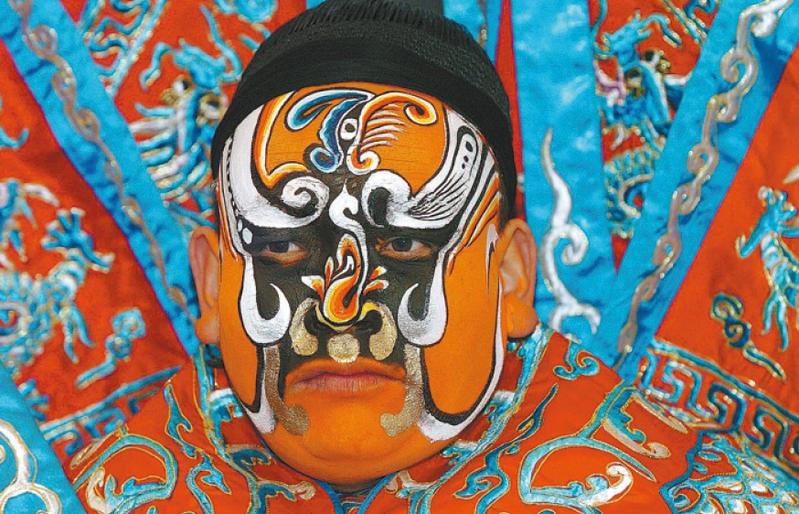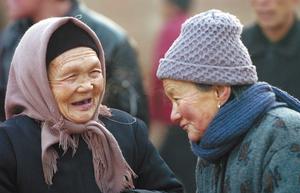 A performer of shehuo, an age-old Shaanxi province art form, painted in traditional and distinctive stage makeup. (PHOTO PROVIDED TO CHINA DAILY)
A performer of shehuo, an age-old Shaanxi province art form, painted in traditional and distinctive stage makeup. (PHOTO PROVIDED TO CHINA DAILY)
Shehuo, a 2,000-year-old performing art form, still plays a leading role in the Spring Festival celebrations in Shaanxi province's Longxian county, which was known as Longzhou in ancient times and remains an important gateway from central China to the country's western regions.
Acclaimed as the "treasure of Chinese folk art" and described as an "inland carnival", shehuo (literally, "village fire") usually features a variety of performances, such as dragon and lion dances, yangko (a popular folk dance) and parades of performers walking on stilts.
According to local cultural researchers, the art form began in the Qin and Han dynasties (221 BC-AD 220) and flourished in the Ming and Qing dynasties (1368-1911).
During Spring Festival in ancient times, rural villages across the county hosted shehuo parades and other cultural activities to offer sacrifices to the "earth gods" and "valley gods". People took this opportunity to pray for blessings and good weather.
In 2003, Longxian was named the "hometown of shehuo" by Shaanxi's provincial government. In 2007, Longzhou shehuo was included in the province's intangible cultural heritage protection list.
The art form is rich in content and features such elements as stilt walking, fire breathing, riding model horses made of bamboo and land-boat (model boats used as stage props) yangko with drums and music, says Yang Bingquan, a folk-art expert with the county's cultural center.
Longxian is particularly known for its "blood shehuo", a unique and characteristic variety in which performances all focus on the theme of punishing evil and promoting goodness. The characters have distinctive personalities, and the makeup is also conspicuous.
"Cart shehuo" is also worth special attention, Yang says. As the name suggests, vans, tractors and other means of transportation become a moving stage where performers-usually children in different costumes-sit motionless on high shelves.
Stilt-walking is the most common feature in shehuo performances, according to Yang. The performers on the wooden stilts play roles in various historical stories. It takes several years of training to master.
"Man-carrying" is an amusing part of the show, Yang adds. The performer is often a robust man with a wooden back frame tied to his shoulders, so that a 10-year-old child can stand on his back to act. As such, the child shouldn't be too heavy.
 The shehuo performances during Spring Festival are a big draw for villagers, especially the elderly people. (PHOTO PROVIDED TO CHINA DAILY)
The shehuo performances during Spring Festival are a big draw for villagers, especially the elderly people. (PHOTO PROVIDED TO CHINA DAILY)
In "floor shehuo", performers are usually clad in simple and easy-to-wear costumes. They act out pantomimes and perform martial arts. There's a chorus of folk songs, and some singers also improvise allegros and stage small plays. The performance, which also features riding model horses made of bamboo and land-boat yangko, is usually carried out daily in the afternoon until late at night.
Most of the performances are inspired by myths, legends and historical stories, Yang says.
Ancient Chinese literary classics like The Romance of Three Kingdoms, The Investiture of the Gods and Journey to the West are often adapted. New content reflecting modern life is also added to the shows.
In spite of its long history, Longzhou shehuo was not known nationally until 2013, when the county hosted a shehuo art festival. Eighteen teams from all over the country took part in the festival and competed for the title of the best shehuo performers.
The team from Longxian won the top spot, and the Chinese Folk Literature and Art Association immediately awarded the county as the "hometown of China's shehuo".
Longzhou shehuo has since become an icon to promote Longxian folk culture. A shehuo festival is held every year from the second to the 15th day of the first lunar month, attracting hundreds of thousands of domestic and foreign tourists.
During the festival, teams of performers line up and walk through the streets and alleys under the command of the sonorous gongs, drums and copper cymbals. Some walk into residents' courtyards to offer blessings.
Local people's love for shehuo has become infused into their blood. Even some elderly people with limited mobility become enthusiastic, as soon as they hear the sound of gongs and drums getting louder and louder from afar, or spot the shehuo team on the street or at the entrance to the village. They follow the team without hesitation. Whenever the shehuo team appears, residents watch wherever they go.
Yang says on-site performances for this Spring Festival are canceled due to the pandemic. But people can still enjoy the show at home and feel the lively Lunar New Year atmosphere without gathering in crowds.
The county's cultural and media-integration centers will post short videos of shehuo performances-rehearsals by villagers-on online platforms Douyin (known as TikTok outside of China) and Kuaishou under its account, "Longxian Intangible Cultural Heritage", from the second to the 15th day of the first lunar month.
Yang says that, through these videos, people can get a better understanding of the age-old art form, and viewers are encouraged to participate in interactive communication.


